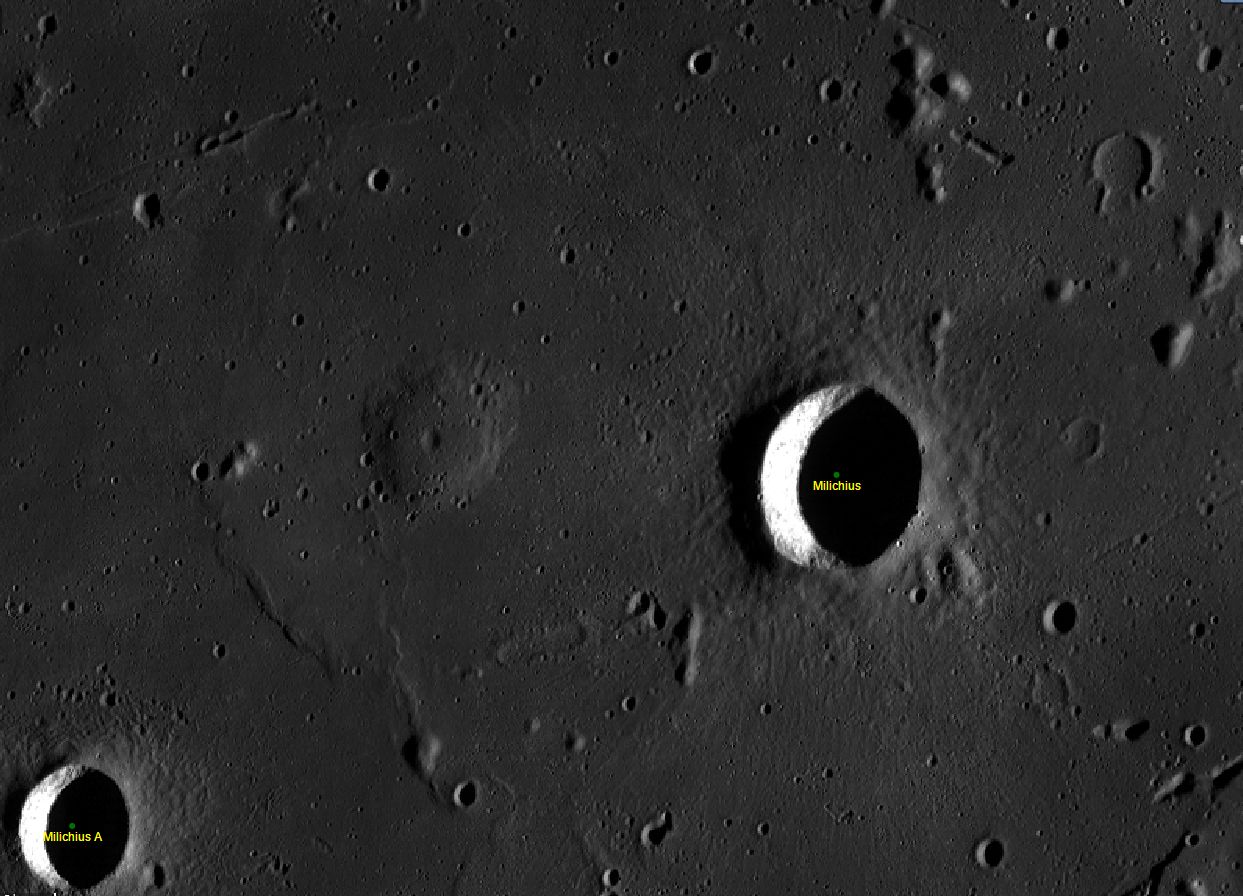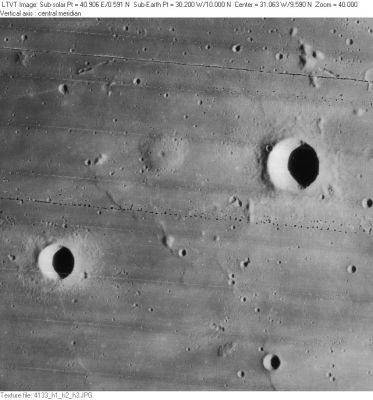Difference between revisions of "Milichius"
| (One intermediate revision by the same user not shown) | |||
| Line 6: | Line 6: | ||
|} | |} | ||
<div id="toc"> | <div id="toc"> | ||
| − | + | [http://www.lpod.org/coppermine/displayimage.php?pid=3179&fullsize=1 [[Image:Normal_Milichius_LO-IV-133H_LTVT.JPG|external image normal_Milichius_LO-IV-133H_LTVT.JPG]]][http://www.lpod.org/coppermine/displayimage.php?pid=3179&fullsize=1 [[Image:Dome%20Milichius.jpg|Dome Milichius.jpg]]]<br /> <br /> ''[http://lpod.org/coppermine/displayimage.php?pos=-3179 LO-IV-133H]'' (Up) '''Milichius''' is the circular crater to the right of center. The 9-km diameter crater on the left is '''Milichius A''', and the 4-km crater near the bottom is '''Milichius K'''. Neither the prominent dome to the west of '''Milichius''', nor the less obvious one to its northwest, both of which have what appear to be volcanic caldera at their summits, have official IAU names, although the more prominent one was formerly known as '''Milichius Pi'''. (Bottom) A LRO version!<br /> <br /> | |
| − | |||
==Images== | ==Images== | ||
[http://www.lpod.org/coppermine/thumbnails.php?album=search&type=full&search=Milichius LPOD Photo Gallery] [http://www.lpi.usra.edu/resources/lunar_orbiter/bin/srch_nam.shtml?Milichius%7C0 Lunar Orbiter Images] [http://www.lpi.usra.edu/resources/apollo/search/feature/?feature=Milichius Apollo Images]<br /> <br /> | [http://www.lpod.org/coppermine/thumbnails.php?album=search&type=full&search=Milichius LPOD Photo Gallery] [http://www.lpi.usra.edu/resources/lunar_orbiter/bin/srch_nam.shtml?Milichius%7C0 Lunar Orbiter Images] [http://www.lpi.usra.edu/resources/apollo/search/feature/?feature=Milichius Apollo Images]<br /> <br /> | ||
| Line 15: | Line 14: | ||
<br /> | <br /> | ||
==Description: Elger== | ==Description: Elger== | ||
| − | ''([[IAU% | + | ''([[IAU%20directions|IAU Directions]])'' MILICHIUS.--Is situated on the N.N.W. of [[Hortensius|Hortensius]]. It is fully as bright, but rather smaller. Its floor, apparently devoid of detail, is considerably depressed below the surrounding surface.<br /> <br /> |
==Description: Wikipedia== | ==Description: Wikipedia== | ||
[http://en.wikipedia.org/wiki/Milichius_%28crater%29 Milichius]<br /> <br /> | [http://en.wikipedia.org/wiki/Milichius_%28crater%29 Milichius]<br /> <br /> | ||
==Additional Information== | ==Additional Information== | ||
| − | * Depth data from [[Kurt%20Fisher% | + | * Depth data from [[Kurt%20Fisher%20Crater%20Depths|Kurt Fisher database]] |
** Arthur, 1974: 2.52 km | ** Arthur, 1974: 2.52 km | ||
** Westfall, 2000: 2.52 km | ** Westfall, 2000: 2.52 km | ||
** Viscardy, 1985: 2.15 km | ** Viscardy, 1985: 2.15 km | ||
** Cherrington, 1969: 1.58 km | ** Cherrington, 1969: 1.58 km | ||
| − | * From the shadows in [http://www.lpi.usra.edu/resources/lunarorbiter/frame/?4133 LO-IV-133H], '''Milichius''' is a little over 2500 m deep. <span class="membersnap">- | + | * From the shadows in [http://www.lpi.usra.edu/resources/lunarorbiter/frame/?4133 LO-IV-133H], '''Milichius''' is a little over 2500 m deep. <span class="membersnap">- Jim Mosher</span> |
* Included in [[ALPO%20list%20of%20bright%20ray%20craters|ALPO list of bright ray craters]] | * Included in [[ALPO%20list%20of%20bright%20ray%20craters|ALPO list of bright ray craters]] | ||
| − | * A low-albedo formation, like '''Mons Moro''' in '''Mare Cognitum''', is detectable slightly west of '''Milichius K'''. See Lunar Orbiter IV's photograph 133H at the top of this page, and also the extreme close up of that formation in the LRO's [http://target.lroc.asu.edu/da/qmap.html ACT-REACT Quick Map], at coordinates LONG: -30.7, LAT: 8.6 <span class="membersnap">- | + | * A low-albedo formation, like '''Mons Moro''' in '''Mare Cognitum''', is detectable slightly west of '''Milichius K'''. See Lunar Orbiter IV's photograph 133H at the top of this page, and also the extreme close up of that formation in the LRO's [http://target.lroc.asu.edu/da/qmap.html ACT-REACT Quick Map], at coordinates LONG: -30.7, LAT: 8.6 <span class="membersnap">- DannyCaes <small>Jun 11, 2011</small></span> |
<br /> | <br /> | ||
==Nomenclature== | ==Nomenclature== | ||
* Named for [http://en.wikipedia.org/wiki/Jacob_Milich Jacob (Milich) Milichius] (January 24, 1501 - November 10, 1559), a German doctor, mathematician, astronomer. He taught at Wittenberg, where he received an M.D. degree and became a professor of mathematics. Among his works was a 1535 commentary on the second book of Pliny. | * Named for [http://en.wikipedia.org/wiki/Jacob_Milich Jacob (Milich) Milichius] (January 24, 1501 - November 10, 1559), a German doctor, mathematician, astronomer. He taught at Wittenberg, where he received an M.D. degree and became a professor of mathematics. Among his works was a 1535 commentary on the second book of Pliny. | ||
| − | * According to [[Whitaker|Whitaker]] (p. 213), this name appeared on [[Riccioli|Riccioli]]'s map, however it was used to name the feature later known as '''Milichius Alpha''' (a peak about 65 km southeast of '''Milichius'''). Exactly who moved the name to the present crater is not clear. <span class="membersnap">- | + | * According to [[Whitaker|Whitaker]] (p. 213), this name appeared on [[Riccioli|Riccioli]]'s map, however it was used to name the feature later known as '''Milichius Alpha''' (a peak about 65 km southeast of '''Milichius'''). Exactly who moved the name to the present crater is not clear. <span class="membersnap">- Jim Mosher</span> |
| − | * None of the domes near '''Milichius''' seem to have been named in the the original [[IAU%20nomenclature|IAU nomenclature]] of ''[[Named%20Lunar%20Formations|Named Lunar Formations]]''. The prominent one to the immediate west of '''Milichius''' was given the name '''Milichius Pi''' on chart [http://the-moon.us/wiki/SLC-E4 SLC E4] of the ''[[System%20of%20Lunar%20Craters|System of Lunar Craters]]'' (1966); but the IAU dropped this name (along with nearly all other Greek-lettered names) in [[IAU%20Transactions%20XVB|1973]], and it has not been officially renamed. <span class="membersnap">- | + | * None of the domes near '''Milichius''' seem to have been named in the the original [[IAU%20nomenclature|IAU nomenclature]] of ''[[Named%20Lunar%20Formations|Named Lunar Formations]]''. The prominent one to the immediate west of '''Milichius''' was given the name '''Milichius Pi''' on chart [http://the-moon.us/wiki/SLC-E4 SLC E4] of the ''[[System%20of%20Lunar%20Craters|System of Lunar Craters]]'' (1966); but the IAU dropped this name (along with nearly all other Greek-lettered names) in [[IAU%20Transactions%20XVB|1973]], and it has not been officially renamed. <span class="membersnap">- Jim Mosher</span>. The elimination of many of the Greek-lettered identifications at domes and hillocks was one of the most unintelligent actions of the IAU. <span class="membersnap">- DannyCaes <small>Mar 14, 2016</small></span> |
* '''Quesada''' (a disallowed name from Van Langren for '''Milichius Gamma''', see page 199 of E.A.Whitaker's ''Mapping and Naming the Moon''). | * '''Quesada''' (a disallowed name from Van Langren for '''Milichius Gamma''', see page 199 of E.A.Whitaker's ''Mapping and Naming the Moon''). | ||
<br /> | <br /> | ||
| Line 40: | Line 39: | ||
A Portfolio of Lunar Drawings (Harold Hill), pages 54, 55, 56, 57.<br /> [http://astroimg.org/articles/IcarusDomesPaper.pdf Wöhler, C. and others] (2006) A combined spectrophotometric and morphometric study of the lunar mare dome fields near Cauchy, Arago, Hortensius and Milichius. ''Icarus.''<br /> <br /> | A Portfolio of Lunar Drawings (Harold Hill), pages 54, 55, 56, 57.<br /> [http://astroimg.org/articles/IcarusDomesPaper.pdf Wöhler, C. and others] (2006) A combined spectrophotometric and morphometric study of the lunar mare dome fields near Cauchy, Arago, Hortensius and Milichius. ''Icarus.''<br /> <br /> | ||
---- | ---- | ||
| − | + | </div> | |
Latest revision as of 02:05, 16 April 2018
Contents
Milichius
|
Lat: 10.0°N, Long: 30.2°W, Diam: 12 km, Depth: 2.52 km, Rükl: 30 |

LO-IV-133H (Up) Milichius is the circular crater to the right of center. The 9-km diameter crater on the left is Milichius A, and the 4-km crater near the bottom is Milichius K. Neither the prominent dome to the west of Milichius, nor the less obvious one to its northwest, both of which have what appear to be volcanic caldera at their summits, have official IAU names, although the more prominent one was formerly known as Milichius Pi. (Bottom) A LRO version!
Images
LPOD Photo Gallery Lunar Orbiter Images Apollo Images
Maps
(LAC zone 57B3) LAC map Geologic map
Description
Description: Elger
(IAU Directions) MILICHIUS.--Is situated on the N.N.W. of Hortensius. It is fully as bright, but rather smaller. Its floor, apparently devoid of detail, is considerably depressed below the surrounding surface.
Description: Wikipedia
Additional Information
- Depth data from Kurt Fisher database
- Arthur, 1974: 2.52 km
- Westfall, 2000: 2.52 km
- Viscardy, 1985: 2.15 km
- Cherrington, 1969: 1.58 km
- From the shadows in LO-IV-133H, Milichius is a little over 2500 m deep. - Jim Mosher
- Included in ALPO list of bright ray craters
- A low-albedo formation, like Mons Moro in Mare Cognitum, is detectable slightly west of Milichius K. See Lunar Orbiter IV's photograph 133H at the top of this page, and also the extreme close up of that formation in the LRO's ACT-REACT Quick Map, at coordinates LONG: -30.7, LAT: 8.6 - DannyCaes Jun 11, 2011
Nomenclature
- Named for Jacob (Milich) Milichius (January 24, 1501 - November 10, 1559), a German doctor, mathematician, astronomer. He taught at Wittenberg, where he received an M.D. degree and became a professor of mathematics. Among his works was a 1535 commentary on the second book of Pliny.
- According to Whitaker (p. 213), this name appeared on Riccioli's map, however it was used to name the feature later known as Milichius Alpha (a peak about 65 km southeast of Milichius). Exactly who moved the name to the present crater is not clear. - Jim Mosher
- None of the domes near Milichius seem to have been named in the the original IAU nomenclature of Named Lunar Formations. The prominent one to the immediate west of Milichius was given the name Milichius Pi on chart SLC E4 of the System of Lunar Craters (1966); but the IAU dropped this name (along with nearly all other Greek-lettered names) in 1973, and it has not been officially renamed. - Jim Mosher. The elimination of many of the Greek-lettered identifications at domes and hillocks was one of the most unintelligent actions of the IAU. - DannyCaes Mar 14, 2016
- Quesada (a disallowed name from Van Langren for Milichius Gamma, see page 199 of E.A.Whitaker's Mapping and Naming the Moon).
LPOD Articles
Bibliography
A Portfolio of Lunar Drawings (Harold Hill), pages 54, 55, 56, 57.
Wöhler, C. and others (2006) A combined spectrophotometric and morphometric study of the lunar mare dome fields near Cauchy, Arago, Hortensius and Milichius. Icarus.
